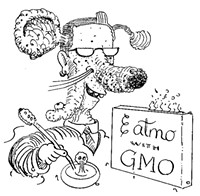What's the story on genetically modified organism (GMO) foods? I'm exposed to a nearly constant stream of horror stories of cancerous death caused by evil GMOs, often including terrifying photos of rats with fist-sized tumors. Is there any truth to the claims of those preaching the anti-GMO gospel? —Brian
"Any" is a sweeping term, Brian. Let's say there isn't much truth—and there better not be. Although GMO foes may not want to admit it, the battle is over. GMOs rule.
Since the mid-1990s, GMO crops have steadily increased in terms of total crop area, with the United States planting more than any other country. For some crops, the great majority of acreage is planted with GMO seeds—notably soybeans. Biotech seed accounts for close to two-thirds of global cotton and roughly a quarter of corn and canola. In the United States, about half of all cropland is growing GMOs, including 93 percent of the acreage for soybeans, 85 percent for corn and 82 percent for cotton.
GMOs are plants or animals with an altered genetic code not found in nature. Genetic modification in the broad sense is nothing new; humans have been creating hybrid plants and animals for centuries, with results ranging from tangelos to killer bees. The difference with GMOs is that they're created by direct modification of the genome rather than traditional breeding methods.
The first GMOs were created by inserting the Bt gene, which gives built-in insecticide properties to plants such as tomatoes, tobacco, corn and soybeans. Since then, genetic modifications have been "stacked"—often via traditional crossbreeding—to produce new crop species with multiple special characteristics. For example, several GMO corn types have been crossed to create one with greater herbicide tolerance.
Gene stacking makes it possible to produce a bewildering array of GMO plants, each of which is adapted for different circumstances. It's estimated that by 2015, at least 24 genetic modifications of corn will be commercially feasible. If they're quadruple-stacked, that could mean more than 12,000 GMO corn varieties.
So, what problems have been reported from GMO crops? Let's dispose of the scariest. In 2012, French molecular biologist Gilles-Eric Séralini, a vocal opponent of genetic modification, published a paper claiming rats that were fed Bt-modified corn treated with Monsanto's Roundup herbicide were much more likely to develop cancer.
The press conference at which the study was released was a transparent—and successful—attempt to manipulate public opinion. In return for a first look at the research, reporters were required to agree they wouldn't ask Séralini's professional peers to check his work. They were shown those photos of rats with bodies grotesquely distorted by enormous tumors, and within hours, the images and other grim details had been tweeted, posted, and blogged around the world 1.5 million times.
Séralini's methods and conclusions were widely disputed by other scientists, and the paper was eventually retracted and republished in much milder form. But the PR damage was done.
Researchers have reported other GMO-linked health issues—food allergies, stomach and uterine inflammation in pigs—but here, too, reviewing scientists have seen problems with methodology. Most studies thus far have found little reason for concern.
That's not to say there aren't legitimate worries about GMO usage, mainly stemming from environmental impact:
• A serious decline in the monarch butterfly population may be due to increased use of herbicides on herbicide-resistant GMO crops, which kills the milkweed plants monarch larvae feed on.
• Chinese GMO cotton crops have seen an increase in second-tier pest insects as the primary pests have been reduced by insecticidal GMO cotton.
It'd be foolish to say nothing will ever go awry with GMO crops. The history of traditional agriculture is full of seemingly bright ideas leading to massive unintended consequences (for example: kudzu, promoted as ground cover till 1953 and now considered a noxious weed, spreading at 150,000 acres annually). That said, GMOs are much more closely regulated than farming experiments of old.
The hot regulatory issue now is labeling. No one can seriously dispute the public's right to know the GMO content of consumer products, but making it happen isn't easy—GMOs must be carefully tracked from planting to market. Laws vary among countries: The European Union requires labeling GMO content at 0.9 percent or more; in China, any GMO content must be indicated; in the United States, labeling is voluntary.
GMO crops have been a boon for farmers, with an estimated $78 billion in additional farm revenue worldwide from 1996 to 2010 due to reduced costs. Since 1996 total pesticide use has dropped by nearly a billion pounds. Reduced carbon emissions due to GMO crops are equivalent to taking 8.6 million cars off the road. Upcoming GMO foods include more-nutritious "golden rice," scurvy-fighting corn, and cancer-preventing tomatoes. Whatever may go wrong, and something surely will, GMO crops are here to stay.
Send questions to Cecil via StraightDope.com or write him c/o Chicago Reader, 350 N. Orleans, Chicago 60654.
More by Cecil Adams
-
This Is the End, My Friend
This week's Straight Dope marks the last appearance of the column as the Teeming Millions have known it for the past 45 years.
- Jul 11, 2018
-
Do Brain Supplements Do Anything?
Brain Drain
- Jul 4, 2018
-
Is flying really worse for the environment than driving?
Planes and Trains
- Jun 27, 2018
- More »




